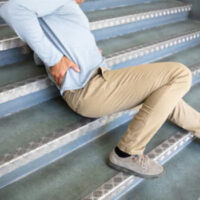Understanding How Friction Impacts Slip and Fall Cases

You don’t need to be a scientist to understand what friction is. But you may not know that friction can get pretty complex when it comes to proving liability in a slip and fall case; so complex that expert scientific testimony may be needed.
How Slippery is the Ground?
The first thing to understand is that people don’t just fall because there’s a foreign substance on the floor, like a spill. People can also be caused to fall simply because the surface of the ground is too slippery. Some floor areas are dangerous in almost any condition.
The measure of how slippery a surface is called the coefficient of friction (COF). Of course, for safety purposes, more friction tends to be safer, because the ground is stickier, and your feet can stay planted to the ground, even if your weight shifts. A low COF means the ground has less friction, is more slippery, and thus you are more likely to fall.
Some surfaces just naturally have a low COF, or get a low COF if they aren’t properly maintained. For example, a surface that is very uneven (for example, a gravel surface) may have a higher COF, but through wear and tear, as it levels off and flattens, that same surface can have a lower COF, to the point that it can even become dangerous.
Liquids and Substances
A liquid or a substance on the floor can drastically reduce the COF of a surface. You know this when you walk through a spill, or when your car hydroplanes on rain-slicked roads. The otherwise grippy asphalt of the road now develops a lower COF when rained on.
Higher Friction
But low COF isn’t the only dangerous condition. A surface with an abnormally high COF can also cause someone to fall, or break ankles or damage knees. If your feet don’t have some room for minor sliding, then the minute they touch the ground they can “stick,” and thus cause someone to fall.
Your Shoes and Soles Matter
Adding to the complexity of the COF analysis is that surfaces with one COF can have higher or lower friction, depending on the material on the surface of your shoes. Some ground surfaces may make rubber soles more tacky, and some may make them more slippery.
The condition of your shoes also matter.
Shoe soles that are worn or weathered may develop a much lower COF than soles that are relatively new. Of course, there’s no law that requires you to buy new shoes every time your soles start to get flat, worn, or weathered. However, this is why in many slip and fall cases, the other side will ask the victim what shoes they were wearing, and may want to inspect the shoes. If the soles are worn down, lowering the COF, the defendant may try to argue that the victim was partly responsible for the fall for the failure to wear safe shoes.
Personal injury cases can involve a lot of scientific evidence. Call the Knoxville personal injury attorneys at Fox, Farley, Willis & Burnette, to help you if you have been injured in any way, in any kind of accident.
Resource:
hyperphysics.phy-astr.gsu.edu/hbase/frict.html
